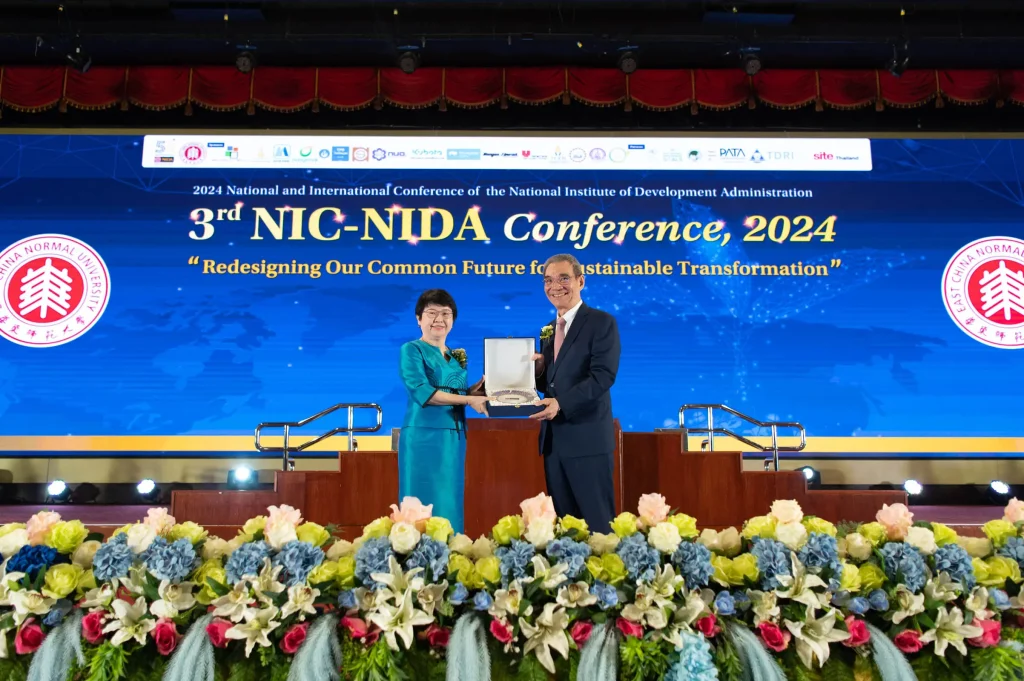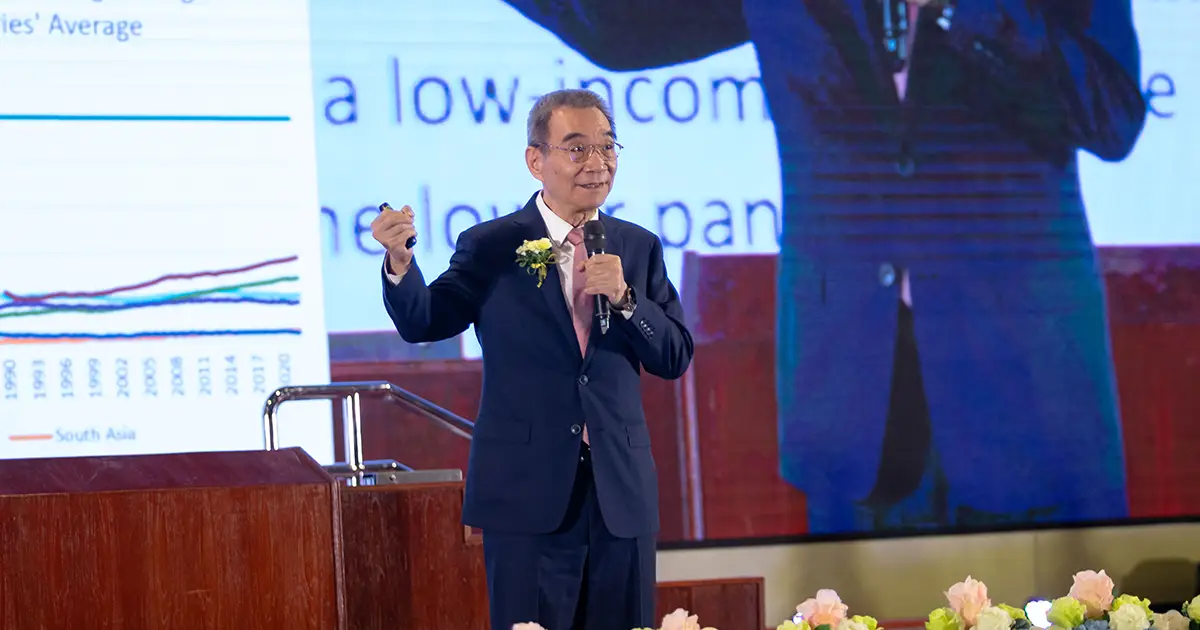Prof. Justin Yifu Lin, Ph.D.
Peking University
Summary of keynote highlights by
Assoc.Prof. Amornrat Apinunmahaku, Ph.D.
At the 3rd National and International Conference of the National Institute of Development Administration (NIC-NIDA), held on August 22-23, 2024, the institution had the honor of hosting Professor Justin Yifu Lin, a distinguished economist from China and the Director of the New Structural Economics at Peking University. Professor Lin delivered a keynote address entitled “China and East Asia’s Rise and Its Implication for Development Economics.”
In his address, Professor Lin provided a historical overview of global economic development, highlighting the division of nations into developed and developing categories since the Industrial Revolution of the 18th century. He noted that, following World War II, many developing nations aspired to achieve economic development on par with high-income countries. During this period, the Asian economy was generally perceived as impoverished with limited prospects for advancement. However, several East Asian economies, including South Korea, Singapore, and Japan, successfully transitioned to industrialized economies. Similarly, China’s shift to a market economy in 1978 precipitated remarkable economic growth, with an average annual growth rate of 9% over 45 years. Consequently, China’s per capita GDP has reached $13,000 and is projected to exceed the $13,485 threshold, thereby attaining high-income status within a few years.
Despite these successes, many other countries have struggled with economic transitions, with some remaining trapped in poverty. This disparity presents a significant puzzle in the field of economic development: why did some economies that appeared promising in the 1950s and 1960s fail to transform into high-income countries, while East Asian economies and China, which were relatively poorer at the time, achieved successful economic transitions?
The Failures of Mainstream Development Economics
Professor Lin articulated his perspectives on global economic development as follows. During the initial phase of economic development from the 1950s to the 1960s, known as ‘Structuralism,’ developing countries were perceived to have lower productivity compared to developed nations. This disparity was attributed to the economic structures of developing countries, which were predominantly driven by agricultural sectors, whereas developed countries had already transitioned to industrial economies. Additionally, developing countries were criticized for low savings rates and the misallocation of resources, which impeded their economic transitions. Structural economists, therefore, recommended that governments in developing countries adopt proactive roles in stimulating savings, reallocating resources, and investing in modern industrial sectors. To reduce reliance on imports, these countries implemented various measures under the import substitution policy to promote domestic investment. Despite the establishment of a few modern, large-scale industries such as steel and automobiles in the 1960s and 1970s, their inefficiencies prevented these countries from achieving high-income status.
Over the subsequent 30 years of economic development following World War II, most developing countries continued to struggle with economic transformation. Economists in the second phase of development economics, known as ‘New Institutional Economics,’ attributed the failures of the developing world primarily to government failures, including excessive government intervention and corruption. Consequently, they advocated for reducing government intervention through the privatization of state-owned enterprises, marketization by promoting market institutions, and supporting trade liberalization. These recommendations, collectively known as the Washington Consensus, were conditions that developing countries had to meet to receive financial assistance from the World Bank or the International Monetary Fund during economic crises. Unfortunately, the implementation of the Washington Consensus did not lead to economic success; rather, the economies of developing countries deteriorated further compared to the first stage under Structuralism, resulting in a lost decade of economic development.
Successful Economic Strategies in East Asian Countries
The successful economic performance of East Asian countries can be attributed to their promotion of industrial transition alongside export-promotion measures, rather than import substitution strategies. Countries such as China, Vietnam, and Cambodia did not adhere to the Washington Consensus, yet they achieved economic stability and significant growth by the 1980s. China, in particular, employed a dual-track approach in its economic development. This approach involved the government implementing import substitution policies to support non-competitive traditional industries while simultaneously promoting small-scale, labor-intensive manufacturing over large-scale, capital-intensive industries. Additionally, the state facilitated market institutions and implemented export-promotion policies through the establishment of special economic zones and industrial parks.
Despite mainstream development economists initially criticizing the dual-track approach for allowing both market and state mechanisms to operate concurrently, China’s economy performed remarkably well, achieving economic stability by the 1980s. It is noteworthy that East Asian economies and China did not follow the Washington Consensus guidelines. Instead, they allowed market forces and government interventions to work in tandem to achieve economic development. In contrast, countries that adhered to mainstream economic development ideas struggled to transform their economies. Consequently, Professor Lin has suggested a reevaluation of development economics, introducing his concept of ‘The New Structural Economics.’
Understanding Economic Structure and Development Determinants
Professor Lin posits that a comprehensive understanding of a nation’s economic structure and the determinants of its development is essential. The economic structure of any economy is typically determined by the nation’s factor endowments, which Adam Smith referred to as ‘the wealth of nations.’ Factor endowments encompass the abundance of resources within a country, such as natural resources, labor forces, and capital. The industrial structure and comparative advantage of a country are generally dictated by these factor endowments, as industries with abundant factor endowments incur lower factor costs of production. However, the competitiveness of an industry is contingent upon its total cost, which includes both the factor cost of production and transaction costs.
Governments can play a pivotal role in reducing transaction costs by enhancing the country’s infrastructure and institutional systems, such as financial institutions and legal frameworks. Professor Lin concludes that the economic development of a nation involves three structural transformations: production structure, infrastructure, and institutional structure. These transformations must be initially driven by the economy’s factor endowments. To elevate a country’s economic development to high-income status, it is imperative to leverage its comparative advantage to minimize factor costs of production. Concurrently, the government must improve infrastructure and institutional structures to reduce transaction costs, thereby lowering the total cost of production and enhancing the country’s competitiveness. As the country generates higher profits from trade, it can accumulate wealth, which constitutes the capital endowment necessary for advancing towards technology-intensive and capital-intensive industries.
The Role of Competitive Markets and Government in Structural Transformation
In the process of structural transformation, competitive markets will reflect relative prices of factors that align with the factor endowments of the economy. Driven by profit-maximizing motivations, domestic entrepreneurs will select technologies and industries that correspond to the country’s comparative advantage, as determined by its factor endowments. Concurrently, the government must create incentives to encourage the first movers in advanced industries and support their success. This can be achieved by investing in infrastructure and improving institutional frameworks. Additionally, the government may need to privatize certain resources to support these first-mover industries that possess a comparative advantage.
Professor Lin highlighted that the primary reason Structuralist economists failed to transform developing economies into high-income countries was their recommendation to promote capital-intensive, large-scale industries, which contradicted the comparative advantages of these nations. Government subsidies and protectionism led to resource misallocation, rent-seeking, and corruption. Conversely, the Washington Consensus’s emphasis on reducing government intervention hindered the promotion of industries with comparative advantages.
The New Structural Economics, proposed by Professor Lin, represents the third generation of economic development theory. He advised developing countries to scale up industries where they have comparative advantages based on their factor endowments. This approach should be combined with two additional conditions: promoting a market economy and maintaining a proactive government. Successful structural transformation, according to Professor Lin, will result in an open economy, macroeconomic stability, and a high economic surplus, ultimately leading to increased savings and investment.



Read news about NIDA International Conference 2024




